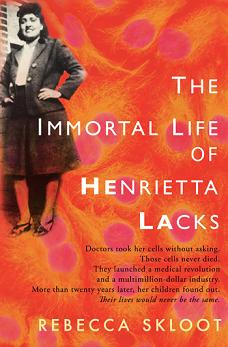He La is the world's first immortal cells. Over the past six decades, scientists have studied them to research everything from cancer to polio to infertility. They have travelled across the country, around the world, even to the moon. He La spawned a multimillion dollar industry. He La is big. Yet its beginnings were small.

Henrietta & David Lacks courtesy www.blackpast.org.
He La stands for a real person, Henrietta Lacks. A Black American woman, she was born and raised in the 1920's in Clover, Virginia. Still a teenager, she married her first cousin. The couple had five children.
Henrietta's husband, however, was a philanderer, infecting his wife with both gonorrhea and syphillis (and likely HPV, the human papilloma virus, an unidentified condition in the 1950's). Offered treatment at the local hospital, she turned it down, likely because she couldn't afford it.
After the birth of her youngest child, Henrietta said she had a "knot" inside her. Her husband took her to Johns Hopkins Hospital in Baltimore, Maryland where she was diagnosed with a tumor on her cervix. Henrietta underwent an operation where the surgeon removed part of her cervix, and stored some of her cancer cells. Doctors treated her with radiation, but the cancer continued to spread. At the tender age of 31, Henrietta Lacks passed away, leaving five young children motherless.

Unknown to her husband or children, doctors at Johns Hopkins started experimenting with her cancer cells. While previous cells had only survived for a short time, Henrietta's cells continued to regenerate. It became apparent that her cells were immortal. While the original doctor who took her cells seemed content to use them for research alone, other recipients of the cells started to use them for profit.
As the cells continued to multiply, their identity was kept top secret. At one point, someone mistakenly claimed that He La stood for Helen Lane, a mistake that many mistook for the truth. Others suggested that He La stood for Helga Larsen. Will the real He La please stand up?

He La cells courtesy www.2palomar.edu.
Finally, in the early 1970's, when the original scientist to work with He La, George Guy, passed away, his colleagues published an article about the cells and revealed their true origin, Henrietta Lacks. The following decade, an Illinois high school science student, Rebecca Skloot, first heard about He La. Her teacher planted a seed which would grow like the cells and eventually lead to a book, The Immortal Cells of Henrietta Lacks.

Ms. Skloot poured over documents, surfed the Internet and made connections to find out as much as she could about He La. Then on day she hit the jackpot -- she tracked down Deborah Lacks, Henrietta's daughter. While Deborah was dubious that Rebecca might want to profit from her mother's cells, she slowly came to the realization that she simply wanted to get to the bottom of her mother's story. Deborah, a young child when her mother died, shared the same desire. The two women bonded over the issue, forging an almost decade long friendship.
Today, He La cells continue to grow. If measured on a scale, scientists estimate their weight to be 50 million metric tons. Rebecca Skloot's book is a #1 New York Times Bestseller and has been translated into 25 languages. Oprah Winfrey is producing a movie about He La. Two syllables that changed history.

*First published in 2014.
No comments:
Post a Comment